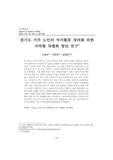

PARTNER
검증된 파트너 제휴사 자료
경기도 거주 노인의 여가활동 장려를 위한 지역별 차별화 방안 연구 (A Study on Regional Differentiation to Encourage Leisure Activities of the Elderly Residing in Gyeonggi Province)
24 페이지
최초등록일 2025.03.18
최종저작일
2015.02

-
서지정보
· 발행기관 : 여가문화학회
· 수록지 정보 : 여가학연구 / 13권 / 1호 / 127 ~ 150페이지
· 저자명 : 오세숙, 이종성, 김종순
초록
본 연구는 경기도 31개 시·군의 노인여가 복지 기반의 유형을 분류하고 경기도 지역 발전지수와 비교한 후, 도출된 유형별 노인여가 복지의 개선방안을 제안하는데 그 목적이 있다. 이를 위해 경기도 시·군별 노인인구수, 재정자주도, 노인여가복지시설 수 및 이용 노인인구, 노인여가 예산액 등의 변수를 활용하여 유형을 분류하였다. 이를 통해 다음과 같은 결과를 얻었다. 첫째, 노인인구수와 재정자주도를 통한 1차 유형은 노인인구가 많고 재정자주도가 높은 지역, 노인인구가 많고 재정자주도가 낮은 지역, 노인인구가 적고 재정자주도가 높은 지역, 마지막으로 노인인구가 적고 재정자주도가 낮은 지역 등 4개의 유형으로 도출되었다. 그리고 노인여가 관련지수인 노인여가 복지시설 수, 노인여가 예산액, 노인종합복지관 이용 노인인구를 통한 2차 유형은 1차 유형에서 분류된 유형 4가지를 토대로 노인여가 관련지수가 높고 낮음에 따라 8가지 유형으로 최종 분류되었다. 둘째, 분류된 유형을 경기도 지역발전지수와 비교분석하여 공통점과 차이점을 도출하였다. 셋째, 분류된 8개의 유형에 대해 ERIC 분석을 실시하였다. 노인여가 활성화를 위해 증가 및 창조해야 하는 요소에서는 노인여가복지시설이나 공원의 숫자와 새로운 노인 여가 프로그램 등이 주로 거론됐으며, 제거 또는 감소시켜야 하는 요소에서는 주로 지역별 대중교통경쟁력이 분석되었다.영어초록
The purpose of this study is to categorize the elderly leisure and welfare infrastructures of thirty-one cities and counties in Gyeonggi province, to compare it with Gyeonggi province development index and to suggest improvement schemes for the elderly leisure and welfare by type. For this aim, this study has classified types by utilizing the number of elderly population, the number of facilities for the aged, the number of elderly population using them, financial independence ratio, and estimated revenues for the elderly leisure by cities and counties in Gyeonggi province. The result of this study as follows. First, the first classification process has resulted in four types such as large elderly population with high revenues for elderly population, large elderly population with low revenues for elderly population, small elderly population with high revenues for elderly population and small elderly population with low revenues for elderly population by using two variables: the number of elderly population and estimated revenues for the elderly leisure. The second classification process has identified four types based on the degree of the elderly leisure index through the four types resulting from the first process. Second, these classified types have been compared with Gyeonggi province development index in order to find common feature and difference. Third, this study has conducted ERIC analysis of the 8 types. In this analysis the number of facilities for elderly leisure and welfare, and the number of urban parks have been used as increasing and creating factors to promote the elderly leisure; on the other hand transportation competitiveness by regions has been also used as eliminating and reducing factors for the same purpose.참고자료
· 없음태그
-
자주묻는질문의 답변을 확인해 주세요

꼭 알아주세요
-
자료의 정보 및 내용의 진실성에 대하여 해피캠퍼스는 보증하지 않으며, 해당 정보 및 게시물 저작권과 기타 법적 책임은 자료 등록자에게 있습니다.
자료 및 게시물 내용의 불법적 이용, 무단 전재∙배포는 금지되어 있습니다.
저작권침해, 명예훼손 등 분쟁 요소 발견 시 고객센터의 저작권침해 신고센터를 이용해 주시기 바랍니다. -
해피캠퍼스는 구매자와 판매자 모두가 만족하는 서비스가 되도록 노력하고 있으며, 아래의 4가지 자료환불 조건을 꼭 확인해주시기 바랍니다.
파일오류 중복자료 저작권 없음 설명과 실제 내용 불일치 파일의 다운로드가 제대로 되지 않거나 파일형식에 맞는 프로그램으로 정상 작동하지 않는 경우 다른 자료와 70% 이상 내용이 일치하는 경우 (중복임을 확인할 수 있는 근거 필요함) 인터넷의 다른 사이트, 연구기관, 학교, 서적 등의 자료를 도용한 경우 자료의 설명과 실제 자료의 내용이 일치하지 않는 경우
찾으시던 자료가 아닌가요?
지금 보는 자료와 연관되어 있어요!
문서 초안을 생성해주는 EasyAI



